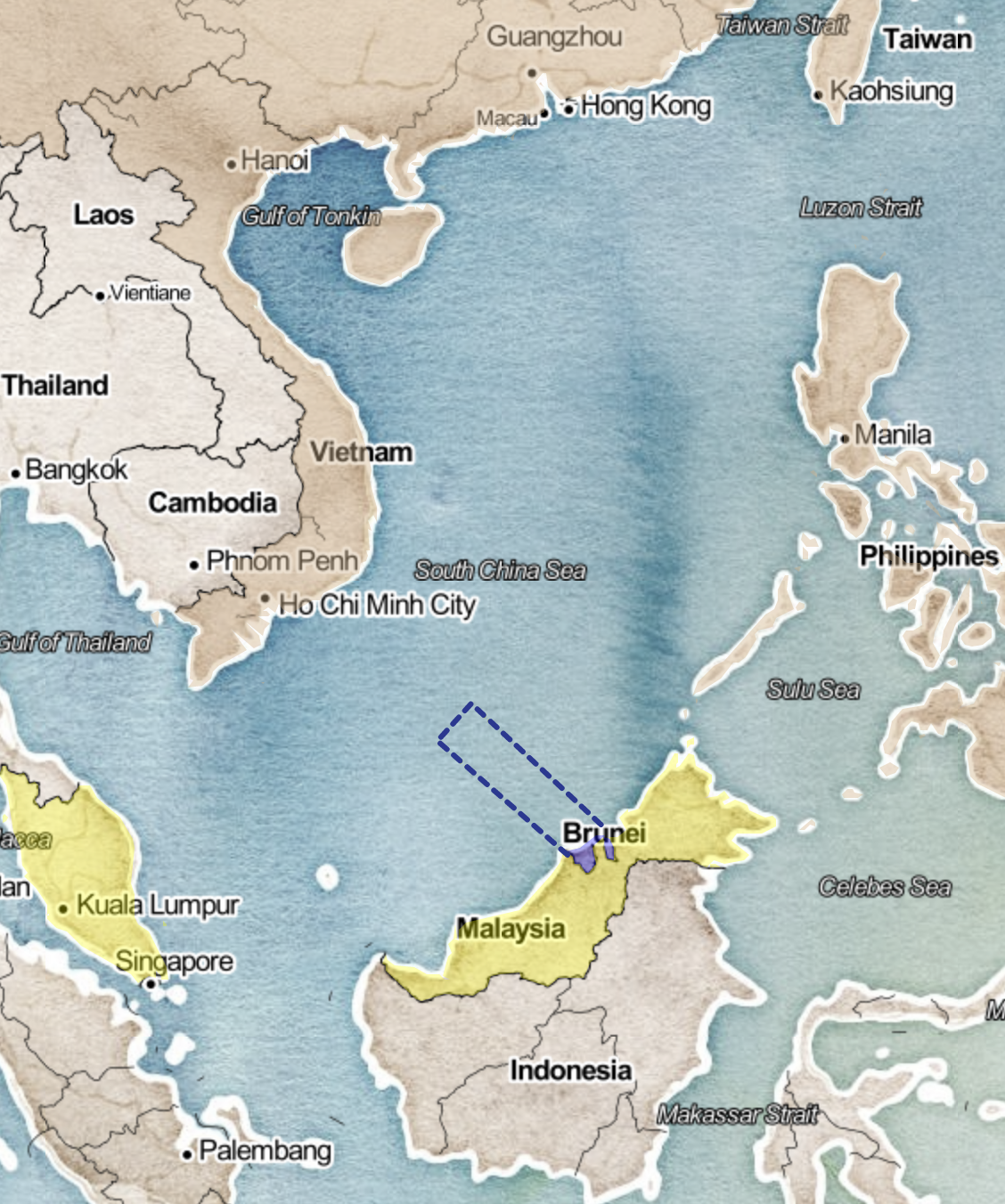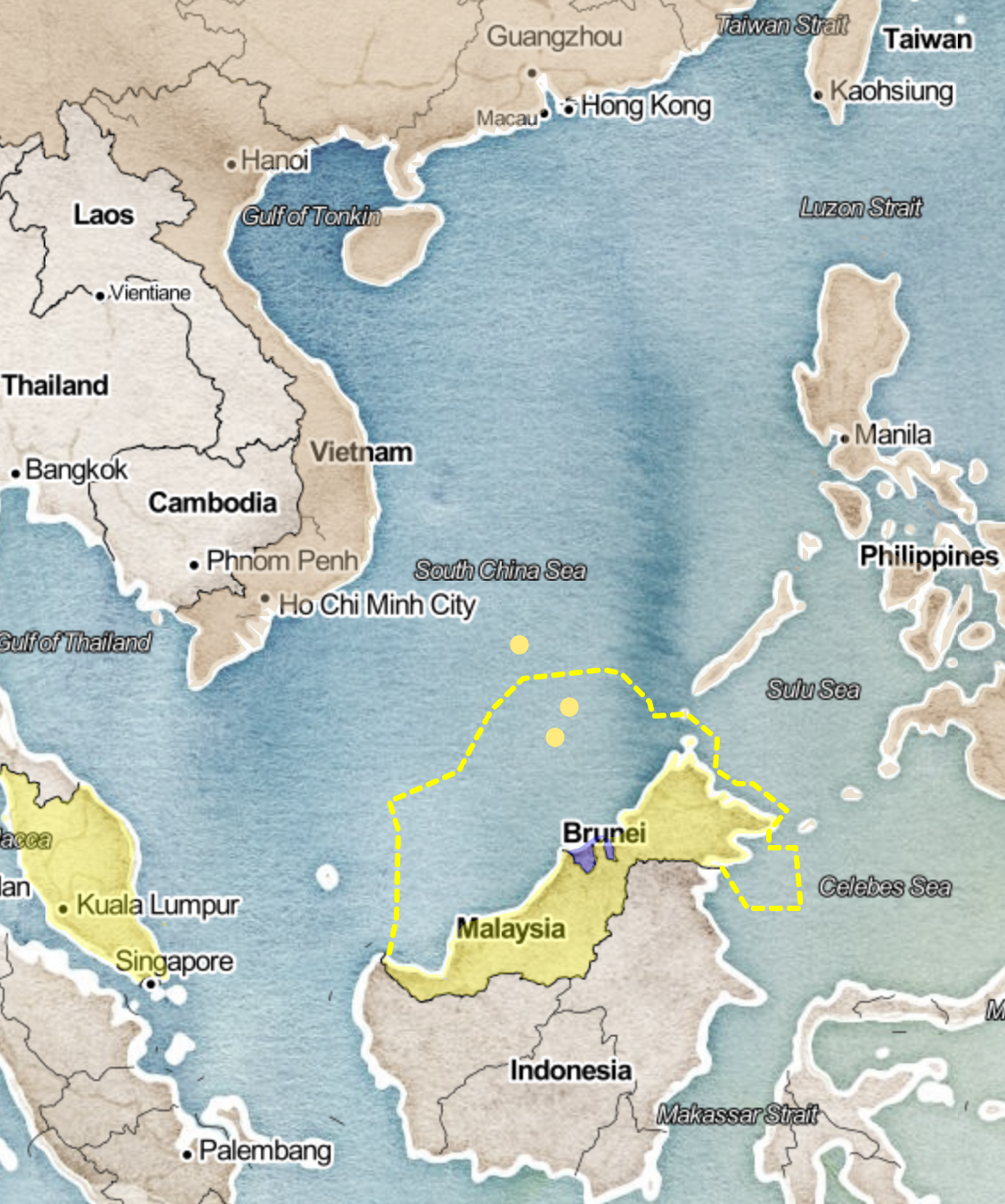X
Map key
 China
China Philippines
Philippines Taiwan
Taiwan Vietnam
Vietnam Brunei
Brunei Malaysia
Malaysia
Disputed Waters
Brunei and Malaysia are the most recent nations to lay claim to parts of the South China Sea. While both countries claim features that fall within their respective EEZ’s as defined by UNCLOS, Brunei claims no islands, whereas Malaysia, whose economy is heavily dependent upon trade with China, claims only a few islands in the Spratlys.

 Brunei
Brunei Malaysia
Malaysia
Brunei
Sometimes referred to as a “silent claimant” to the South China Sea, Brunei first asserted rights to a roughly rectangular chunk of the disputed sea shortly after gaining independence from Britain in 1984.
Maritime features such as Bombay Castle, Louisa Reef, Owen Shoal, and Rifleman Bank, all fall within Brunei’s Exclusive Economic Zone, but the small oil-rich kingdom claims only Louisa Reef, which lies upon its continental shelf. Because Louisa Reef is part of the Spratly islands, that feature is also claimed by China and Vietnam.
Brunei is the only claimant state that does not occupy any maritime features or maintain a military presence in the region.
Principal economic interests
Energy: The tiny sultanate’s rapidly diminishing hydrocarbon resources account for some 60 percent of gross domestic product (GDP) and 90 percent of total export profits. According to the CIA’s World Factbook: “Crude oil and natural gas production account for approximately 65 percent of GDP and 95 percent of exports, with Japan as the primary export market.” Development of offshore oil and gas fields, both within the country’s territorial waters as well as within its contested EEZ, are outlined as part of its long-term national vision program, “Wawasan Brunei 2035.”
According to the U.S. Energy Information Administration, the Southeast Asian country has reserves of 1.5 billion barrels of crude oil and liquids reserves, and 15 trillion cubic feet of natural gas beneath the seabed.
Fishing: According to the London-based Oxford Business Group, Brunei’s gross fisheries output stood at $78.3 million in 2015, representing 0.4 percent total GDP for that year.
Shipping: Nearly all of Brunei’s manufactured goods and food are imported.

Malaysia’s Prime Minister Najib Razak, left, talks with China’s President Xi Jinping at the Asia-Pacific Economic Cooperation summit in Manila, Philippines in 2015. Najib arrived in the Chinese capital on Nov. 1, 2016 for a six-day visit to the country whose claims to virtually the entire strategic waterbody overlaps with areas that Malaysia says belong to it. (AP Photo/Susan Walsh)

 Brunei
Brunei Malaysia
Malaysia
Malaysia
Malaysia claims a portion of the South China Sea north of Borneo, which encompasses at least 12 features in the Spratly Islands chain, including Vietnam-occupied Amboyna Cay and Barque Canada Reef, along with Commodore and Rizal reefs, which are both occupied by the Philippines. Of the low-tide elevation features claimed by Malaysia, only three completely submerged reefs are on its continental shelf.
Malaysia controls
Swallow, Ardaiser, Erica, Mariveles and Investigator reefs. According to U.S.-based CNA, a nonprofit research organization that operates the Center for Naval Analyses and the Institute for Public Research, these are perhaps the only Malaysian-claimed features that could generate maritime zones.
Principal economic interests
Energy: According to the U.S. Energy Information Administration, the Southeast Asian country has reserves of 5 billion barrels of crude oil and liquids reserves, and 80 trillion cubic feet of natural gas beneath the seabed, the highest proven and probable estimate of any South China Sea claimant nation.
Fishing: Malaysia is the world’s 15th largest marine catch producer in the world. According to U.S.-based CNA, Malaysia produced 1.5 million tons of fish in 2012, representing 1.85 percent of total global production for that year.
Regional infrastructure
Malaysia maintains one landing strip for C-130′s on Swallow Reef, along with a military presence on Investigator Shoal and Mariveles, Ardaiser and Erica reefs, according Robert Kaplan, chief geopolitical analyst for Stratfor.
In 1983, Malaysia naval forces poured sand into a channel separating two reefs to create the 20-hectare islet of Layang Layang, which is now home to deep-sea diving resort. The three-star Avillion Layang Layang maintains 86 guestrooms in a half-dozen buildings made of tropical hardwood. The resort offers guests a freshwater swimming pool, Jacuzzis, spa, restaurant and lounge bar.
